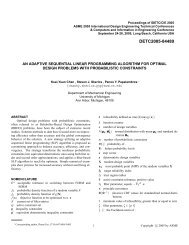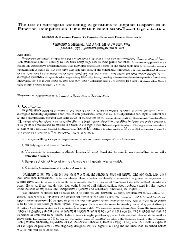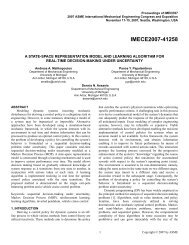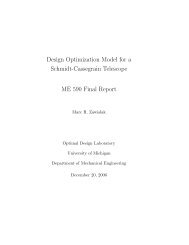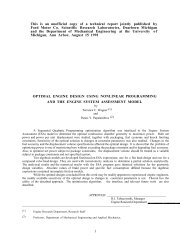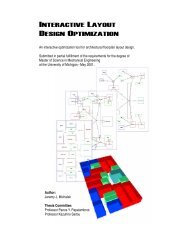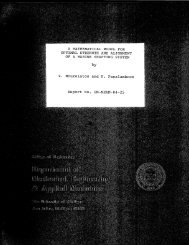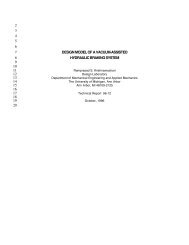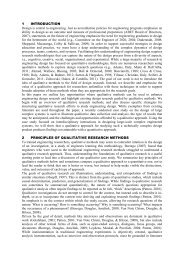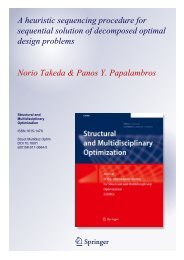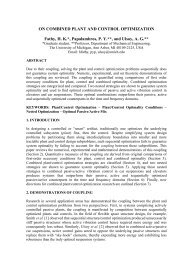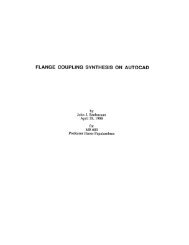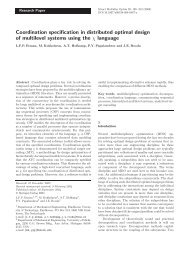Decomposition Analysis of an Automotive Powertrain Design ...
Decomposition Analysis of an Automotive Powertrain Design ...
Decomposition Analysis of an Automotive Powertrain Design ...
Create successful ePaper yourself
Turn your PDF publications into a flip-book with our unique Google optimized e-Paper software.
6 COORDINATED OPTIMIZATION SOLUTION<br />
Assume a vehicle segment has been selected with the acceleration targets 0-60 time τ 0 =<br />
11.0 sec, 5-20 time τ 1 = 1.81 sec, four second dist<strong>an</strong>ce S base = 88.4 ft. Assume body <strong>an</strong>d chassis<br />
decisions have yielded the vehicle parametervalues given in the appendix. This leaves as variables<br />
the engine geometry <strong>an</strong>d egr schedule, x 1 = (b, s, c r , d i , d e , L mi , D mi , L me , D me i vo , i vc , e vo , e vc ,<br />
d bm , l bm , d br , l br , i lift , e lift, F egr ), <strong>an</strong>d tr<strong>an</strong>smission gears <strong>an</strong>d torque converter size, x 2 = (ξ 1 , ξ 2 ,<br />
ξ 3 , ξ 4 , ξ fd , ξ sp<strong>an</strong> , α t ,i gear ) to be optimized. The coordination strategy begins by solving for all<br />
initial values in SP to create a starting point for MP (a map <strong>of</strong> fuel flow, NOx emissions, <strong>an</strong>d<br />
m<strong>an</strong>ifold pressure as a function <strong>of</strong> engine speed <strong>an</strong>d torque based on the initial engine design, <strong>an</strong>d<br />
a wide-open throttle torque curve).<br />
Table I summarizes the results <strong>of</strong> the strategy. The first column identifies geometric <strong>an</strong>d<br />
behavior variables in the MP <strong>an</strong>d SP; the second lists the variable name; the third gives the units.<br />
The initial values <strong>of</strong> the variables <strong>of</strong> interest (geometric <strong>an</strong>d behavior) are given in the fourth<br />
column. The next seven columns give results as the strategy sequences through optimization in the<br />
MP <strong>an</strong>d SP. Note that the final point <strong>of</strong> MP defines the displacement <strong>of</strong> the engine in the initial<br />
point <strong>of</strong> SP. Similarly, the final point <strong>of</strong> SP defines the fuel flow <strong>an</strong>d emissions used in MP.<br />
The coordination strategy converged in two overall iterations <strong>an</strong>d improved the fuel<br />
economy by 10.8% (3 mi/gal) relative to the baseline powertrain. At the feasible starting point,<br />
(column IV) none <strong>of</strong> the acceleration constraints are active: τ 0-60, τ 5-20, <strong>an</strong>d S base are within the<br />
bounds by 0.7 seconds, 0.1 seconds, <strong>an</strong>d 4.0 feet respectively. In the solution to the first iteration<br />
<strong>of</strong> MP (column V), the step-down ratio ξ 1 /ξ 2 is reduced, the final drive ratio is nearly unch<strong>an</strong>ged,<br />
the size factor on the torque converter α t , is increased, the engine is down-sized by 8%, <strong>an</strong>d the<br />
gear box sp<strong>an</strong> is increased by 0.1 ratios. First gear ratio ξ 1 is reduced by 20%; the second ξ 2 by<br />
10%; <strong>an</strong>d the fourth ξ 4 by 18%. The active constraints are the 0-60 time τ 0-60 <strong>an</strong>d the bound on<br />
the torque converter scaling factor α t . The fuel economy is improved by 7.9%. Gradeability<br />
criteria are virtually unaffected.



